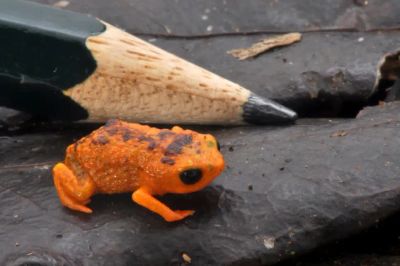Added: 11th January 2024 by MathWorks
What is tiny, bright orange, and really bad at jumping? The answer is a small amphibian found in the mountainous forests of Brazil, aptly called pumpkin toadlets. These tiny frogs are barely a centimetre long at maturity and are (in)famous for their jumping skills.

While frogs are typically known for their ability to clear large distances in a single jump, mainly as a means to escape predators, these tiny amphibians seem to lack the aerial skills needed to be a frog. Each jump results in an uncontrolled crash landing.
Gizmodo reported, “[Pumpkin toadlets are] actually decent at jumping upward; it’s the coming down that’s disastrous. The pumpkin toadlets are simply unable to control their landings. A team of researchers recently looked into the faulty gymnastics of these frogs, and their findings are published in Science Advances.”
Researchers looked into the cause of the clumsiness and found it may be related to the toadlets’ size.
“[…] having a body smaller than that of a honey bee comes with some pretty clear functional consequences,” Martha Muñoz, a biologist at Yale University, told The Atlantic. “Pumpkin toadlets have shrimpy legs and arms, and fewer fingers and toes than other frogs; their high surface-area-to-volume ratio makes them easily dry out. The teeny toadlets also have all sorts of issues with their head, which can shrink only so much before it malfunctions.”
Small heads mean there is very little real estate for all things contained in the skull. Researchers suspect that the frogs’ crash landings may be due to their inability to balance mid-leap due to their miniature stature and even smaller ears.
The researchers made CT scans of the inner ears of 147 frog species. They determined that the pumpkin toadlets’ semicircular ear canals are the smallest ever recorded for adult vertebrates.
The researchers recorded the frogs jumping and analysed the footage. They recorded each jump from the side and from above. They needed to determine the toadlet’s orientation throughout the jump. But the orientation of a minuscule projectile as it pirouetted through the air required specialised tools.
To analyse the videos, the recordings were digitised using the DLTdv7 application in MATLAB with an eight-point calibration cube. The researchers digitised two landmarks in both camera views to generate three-dimensional coordinates for the tip of the snout and the tip of the tailbone. Body angle was calculated as the angle formed by a line connecting these two landmarks and the horizontal, which was determined by projecting a point in the y direction.
Their analysis of the videos revealed that changes in the rotation speed of the tiny frogs were the lowest among the group of amphibians in the study. High rotation speeds are needed by jumping creatures to give them time to orient themselves before they return to the ground. To make matters worse, the team determined that the change in rotation speed was lowest when the toadlets were mid-air. “This suggests that the toadlets find this stage the hardest to track with their insensitive ear canals and end up flopping to the ground instead of landing on their feet, New Scientist’s Jake Buehler reports.”
While they are lousy at landing, it doesn’t seem to matter. When they land, they tend to remain motionless for an extended time, allowing them to escape predators after all. They match the leaf debris on the forest floor and are hard to find.